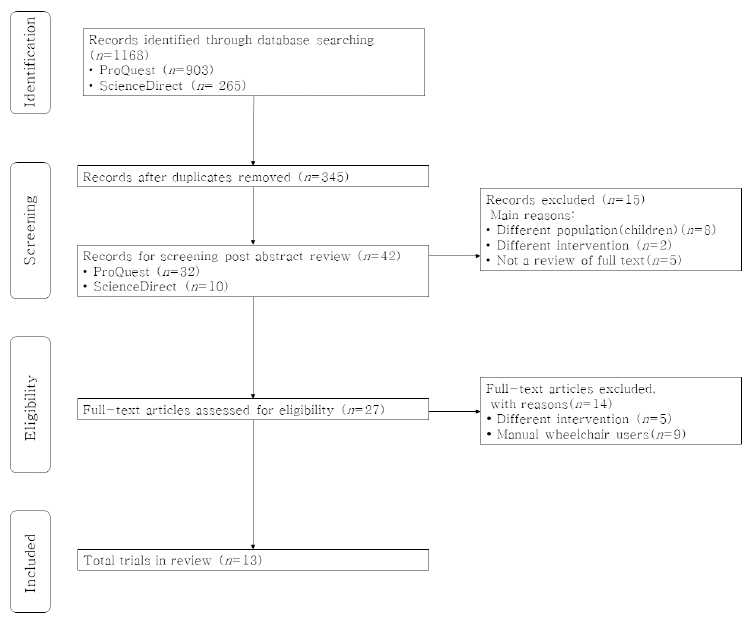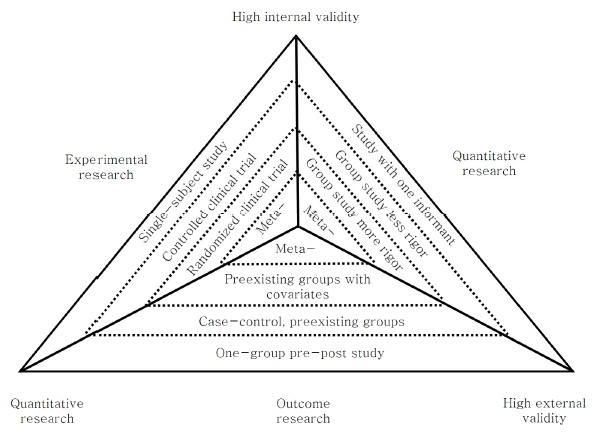서 론
이동은 활동과 참여에 있어서 강조되는 주요 영역으로 건강상태, 삶의 질 측면에서 가장 기본이 되는 요소이다 (World Health Organization [WHO], 2001). 외상성 뇌손상, 척수손상, 다발성 경화증, 절단장애인 그리고 통 증과 피로로 인해 이동성에 제한을 갖는 사람들은 이동 성 증진, 기능적 수행과 참여를 위해 휠체어를 사용한다 (Bunning, Angelo, & Schemeler, 2001). 휠체어 사용 자들은 하루 7시간에서 8시간 동안 휠체어에 착석하고 있어 피로, 착석압력 증가로 인한 욕창 등을 경험하고 있 는데 이들 휠체어 사용자 중에서도 스스로 자세조절이 어려운 장애인 즉, 상지 및 체간 조절능력에 제한이 있는 장애인은 착석 안정성을 유지하기 어렵기 때문에 전동휠 체어의 착석기능 옵션이 필요하다(Woo, Jang, & Kim, 2016).
전동휠체어의 착석기능(Powered Seating Function; PSF)은 틸트(tilt in-space), 등받이 리클라인(backrest recline), 거상식 발 받침대(elevating leg-rest) 그리 고 착석좌면 상승기능(seat elevator)을 일컫는 것으로 이러한 전동휠체어의 착석기능들은 기립성 저혈압, 자율 신경반사부전, 강직 그리고 부종과 같은 휠체어 사용자 들의 합병증을 감소시키는 것으로 나타났다(Cowan et al., 2012; Ding et al., 2008; Liu, Kelleher, Pearlman, & Cooper, 2014). 이처럼 전동휠체어의 착석기능들은 클라이언트 요소에 포함되는 신체기능에 긍정적인 영향 을 미친다. 미국의 경우 작업치료사는 클라이언트에 대 한 체계적인 평가와 더불어 휠체어에 대한 기본 사양, 옵 션과 부속품에 대한 선택 및 처방을 하고 장애인들이 국 가로부터 그들이 사용할 휠체어에 대한 펀딩을 받을 수 있도록 의학적 필요성(medical necessity)을 제시하는 역할을 한다(Johnson & Fitzsimmons, 2010). 그러나 우리나라는 휠체어 옵션이나 부속품들이 휠체어 공급업 체에 의해 클라이언트에게 선택적으로 제공되어 체계적 인 보조공학 서비스 전달에 어려움을 가지고 있는 실정 이다. 이로 인해, 전동휠체어 착석기능에 대한 중증장애 인들의 니즈가 있음에도 불구하고 획일화된 이동성 보조 기기관련 급여제도로 인해 착석기능이 있는 휠체어 구입 에 대한 이들의 경제적 부담률이 높은 상태이다(국민건 강보험공단, 2016: Woo, Jang, & Kim, 2016). 따라서 휠체어 관련 급여제도에 대한 문제점 인식 및 개선방안 마련과 더불어 휠체어를 비롯한 옵션 및 부속품까지 세 부적인 것들을 처방하는 작업치료사의 역할의 중요성이 강조되어야 한다. 이에 작업치료사에게는 클라이언트의 기능과 환경에 맞는 휠체어를 처방해줄 수 있도록 다양 한 휠체어 및 옵션에 대한 근거기반의 이해가 우선되어 야 할 것이다. 국내 작업치료사들이 이미 교과과정을 통 해 전동휠체어 착석기능에 대한 기본적인 정의와 특징에 대해 인지하고 있을 것으로 예상하나 임상에서 전동휠체 어 착석기능이 어떤 목적과 방법으로 중재되고 있는지에 대한 연구 및 근거들은 미비한 상태이다. 또한 휠체어 지 지구조물 및 추진 구조물에 대한 국내 연구만 있을 뿐 전 동휠체어 착석기능에 대한 연구는 찾기 어렵다.
따라서 본 연구의 목적은 체계적 고찰을 통하여 전동 휠체어 착석기능의 중재가 임상에서 어떤 목적과 방법으 로 제공되고 있으며 휠체어 사용자들에게 어떤 영향을 미치는지에 대한 근거들을 제시하고자 한다. 또한, 휠체 어 관련 서비스를 제공하는 작업치료사들에게 전동 휠체 어 착석기능에 대한 정보를 공유하고 더 나아가 전동휠 체어 급여제도 개선을 위한 전동휠체어 착석기능의 유용 성을 제시하고자 한다.
연구 방법
1.검색방법 및 분석대상
본 연구는 2007년 이후부터 2016년까지 학회지 온라 인 데이터베이스에 등록된 논문을 포함하였다. 데이터베 이스는 ScienceDirect, ProQuest를 이용하였으며 검색 용어는 “Power wheelchair user” OR “Handicapped with people” AND “Tilt-in-space” OR “Backrest recline” OR “Elevating legrest” OR “Seat elevator” OR “Power Seat Function(PSF)” 사용하여 검색하였 다. 제 1저자가 총 1168개의 문헌을 검색한 후 중복 게 재된 문헌을 제외하고, 제목과 초록 확인을 통해 포함기 준에 해당하는 문헌을 선정하고 원문을 검토하여 최종적 으로 총 13개의 연구를 선정하였다(Figure 1). 본 연구 의 포함기준과 제외기준은 다음과 같다.
2.분석대상 연구의 질적 수준
최종 선택된 연구들에 대한 질적 수준을 평가하기 위 해 Tomlin과 Borgetto(2011)의 연구에서 제시한 Research Pyramid Model(RPM)을 사용하였다. RPM 은 질적 연구에 대한 근거수준이 마련되어 있지 않고 대 규모 모집단 기반 결과 연구를 낮은 수준의 근거로 격하 한 기존의 단일계층 Evidence Based Practice(EBP) 모델을 보완한 근거수준 모델로 작업치료사들이 임상에 서 의사결정을 할 수 있도록 정보를 제공하고 각기 다른 연구 디자인들의 근거를 피라미드 형태의 다양한 계층으 로 나뉜다(Arbersman et al., 2008). RPM은 총 네 개 의 면으로 구성되어 한 면은 질적연구, 다른 한 면은 결과 연구, 나머지 한 면은 실험연구 그리고 바닥면에 기술연 구의 근거수준이 층별로 구성되어 있다. 연구의 질적 수 준에 대한 계층 구조가 삼각형의 각 면에 설정되어 있는 데 피라미드의 층은 연구의 엄격성에 따라 형성된다. 예 를 들어 실험 연구 면에 단일대상연구는 바닥수준에 위 치해있고 그 위층은 대조 임상실험 연구 그 위층은 무작 위 대조연구가 위치한다. 질적 연구에 대한 근거 수준을 파악할 수 있는 것이 이 모델의 장점으로, 질적 연구의 엄격성은 연구 참여자의 검토, 삼각측량(다양한 방법으 로 자료 수집하는 것), 그리고 연구 참여자들의 장기적인 참여여부에 따라 결정된다(Tomlin & Borgetto, 2011). RPM의 근거수준에 대한 자세한 내용은 Figure 2와 Table 1에 제시되어 있다.
Table 1
Research Pyramid Levels of Evidence
연구 결과
1.분석대상 연구의 근거 수준
총 13편의 대상연구 중 기술적 연구 2편은 근거수준 Ⅰ, 3편은 근거수준 Ⅲ이었다. 결과연구 4편은 근거수준 Ⅲ, 1편은 근거수준 Ⅳ이었다. 그리고 질적 연구가 3편으 로 근거수준 Ⅱ이었다(Table 2).
Table 2
Type and Evidence Levels of Studies
2.연구 분석
기술적 연구, 결과 연구, 질적 연구에 포함된 각각의 연구들을 체계적으로 정리하기 위해 저자/연도, 연구 참여 자, 연구목적, 결과 및 효과 순으로 나열하였다(Table 3).
Table 3
Analysis of the Included Descriptive Studies
3.분석대상 연구의 특징
기술적 연구
5개 중 2개의 연구는 Assistive technology 학회지를 통해 북미재활공학 및 보조공학협회(Rehabilitation Engineering and assistive technology Society of North America; RESNA)에서 발간된 것으로 전동 휠 체어 착석기능에 대한 임상적용과 근거들을 제시하고 있 다. 이들 연구에서 전동휠체어 착석기능은 휠체어 사용 자들에게 의학적으로 필요한 기능이고 일상생활기능을 증진시키는데 중요한 역할을 한다고 강조하고 있다 (Arva et al., 2009; Dicianno et al., 2009). 기술적 연 구에 포함된 연구에서 전동휠체어 착석기능 중 거상식 발 받침대에 대한 사용빈도를 측정한 연구가 포함되지 않아 4가지 착석기능에 대한 각각의 사용빈도를 파악하 기 어려웠으나 전동 휠체어 착석기능의 사용빈도에 대해 조사한 결과 휠체어 사용자가 하루에 틸트를 19±14번 으로 가장 많이 사용하고 등받이 리클라인 12±8번, 그 다음으로 착석좌면 상승기능은 4±4번 사용하는 것으로 나타났다. 특히 틸트는 사용목적에 따라 0゚~15゚ 또는 15゚ ~29゚ 틸트를 하고 있고 또 다른 연구에서는 전동휠체어 사용자들이 착석압력 경감이 목적일 때는 27분마다 30゚ 이상의 틸트를 사용하는 것으로 나타났다(Ding et al, 2008; Sonenblum & Sprigle, 2011a; Sonenblum, Sprigle, & Maurer, 2009).
결과 연구
Sprigle 등(2010)은 정상인과 척수손상 클라이언트 를 대상으로 각각 다른 5가지 각도의 틸트, 등받이 리클 라인과 스탠딩기능을 적용한 결과 척수손상 클라이언트 에게는 180゚ 등받이 리클라인, 90゚ 스탠딩 상태에서 엉 덩뼈에 가해지는 착석압력이 감소한 것으로 보고하였고 Soneblum와 Sprigle(2011a)의 연구에서는 엉덩뼈의 압력경감을 위해서는 30゚ 이상의 틸트를 권장하였고 혈 류량 증가가 목적이라면 45~60゚의 틸트를 권장하였다. Jan 등(2013)은 틸트와 등받이 리클라인 각도에 대해 6가지 프로토콜 및 적용기간에 대해 제시하였고 엉덩뼈 부분의 피부 관류량이 증가됨을 보고하였다. 그 밖의 연 구에서도 틸트와 등받이 리클라인이 결합된 프로토콜 중 25゚이상의 틸트가 포함된 프로토콜에서 엉덩뼈와 꼬리 뼈에 가해지는 착석압력이 감소되는 것을 볼 수 있었다 (Chen, Lung, Crane, & Jang, 2014)
질적 연구
착석좌면에 가해지는 압력을 관리하기 위해 사용자가 휠체어를 어느정도 틸트하여 사용하는지와 치료사가 전 동 휠체어 착석기능을 어떤 목적으로 처방하는지에 대한 반 구조화된 인터뷰를 실시 한 결과 전동휠체어 사용자 들은 중간각도의 틸트 또는 작은 각도의 틸트를 주로 사 용하였고 치료사는 착석압력 관리를 위해 사용자의 배경 적 요소를 고려하여 큰 각도의 틸트를 처방하는 것으로 나타났다(Titus, 2013). Shankar, Mortenson와 Wallace (2014)의 연구에서는 요양원에 거주하는 휠체어 사용자 들이 어떻게 틸트를 사용하는지 인터뷰한 결과, 이들은 편안함 증진과 참여를 위해 틸트기능을 사용하고 이로 인해 휠체어 내에서의 독립적으로 움직일 수 있게 되어 다양한 활동에 능동적으로 참여할 수 있다고 하였다. 또 한, Liu, et al., (2014)의 연구를 통해 임상가들은 전동 휠체어 착석기능 사용자의 선호도, 신체적 상태, 환경적 세팅과 임상 착석 평가를 통해 사용자들이 수행하고자 하는 과제를 고려하여 전동휠체어 착석기능을 권고하는 것으로 나타났다.
고 찰
본 연구는 체계적 고찰을 통해 전동 휠체어 착석기능 이 임상에서 어떤 목적과 방법으로 중재되고 있는지 분 석하여 휠체어 관련 보조공학 서비스를 하고 있는 작업 치료사들에게 전동 휠체어 착석기능에 대한 정보를 공유 하고 착석기능에 대한 유용성을 알리고자 하였다.
기술적 연구에 포함된 연구에서 전동휠체어 착석기능 중 거상식 발 받침대에 대한 사용빈도를 측정한 연구가 포함되지 못해 4가지 착석기능에 대한 전반적 사용빈도 를 파악하기 어려웠으나 주로 틸트와 등받이 리클라인 기능과 관련된 연구들이 앞서 진행된 점, Ward, Hammond, Holsten, Braver와 Brooks(2015)의 연구 에서 근위축성 측색 경화증 클라이언트들이 전동휠체어 구입 후 6개월 까지 시간이 경과될수록 4가지 착석옵션 중 틸트, 등받이 리클라인 착석기능을 사용했다는 결과 로 미루어볼 때 전동 휠체어 착석기능 사용자들이 틸트 와 등받이 리클라인 기능을 주로 사용한다는 것을 예측 할 수 있었다. 하지만 추후 전동 휠체어 착석기능 사용빈 도에 대한 연구를 여러 집단을 대상으로 실시하여 정확 한 사용빈도에 대한 근거를 마련해야 할 것이다.
전동 휠체어 착석기능을 처방하고 권고하는 전문가인 작업치료사 및 보조공학 전문가들은 휠체어 사용자의 착 석압력감소, 안정성 개선, 휠체어 내에서의 편안함과 휴 식을 위해 그리고 클라이언트들이 일상생활수행과 관련 된 활동을 안정적으로 수행할 수 있도록 중재하였다. 이 와 더불어 휠체어 사용자들은 피로감소와 몸통 및 하지 의 강직 조절, 일상생활수행 할 때 휠체어 내에서의 편안 함과 안정성을 확보하고 참여하는 것을 목적으로 착석기 능을 사용한다는 것을 알 수 있었다(Liu, et al., 2014; Shankar, et al., 2014; Titus, 2013). 휠체어 내에서의 활동 시 안정성과 편안함은 그들이 일상생활수행능력 수 준의 질을 높일 수 있는 기반이 되고 여가증진의 수단으 로 작용하였으며 휠체어 전반에 대한 만족도 증진에 유 의한 영향을 미치는 요인이다. 따라서 작업치료사들은 안정성과 편안함을 휠체어 관련 중재의 결과지표로 인식 해야 할 것으로 사료된다(Sonenblum, et al., 2009; Visagie, et al., 2016). 이러한 견해를 뒷받침하기 위해 전동 휠체어 착석기능 사용결과 사용자에게 획득되는 휠 체어 내에서의 편안함과 안정성이 사용자의 일상생활수 행능력에 어떠한 영향을 미치는지에 대한 연구가 필요하 다. 또한 휠체어 내에서의 안정성 및 편안함과 참여에 대 한 상관관계에 대한 연구도 시행되어야 할 것이다.
전동휠체어 착석기능 중재 목적에 따라 틸트와 등받이 리클라인의 기울기가 다르게 결합하여 적용되고 있었다. 중재목적이 엉덩뼈에 가해지는 압력감소라면 20゚~45゚ 이상 좌석을 틸트하고등받이를 100゚~ 120゚ 리클라인하 여 30분마다 30초씩 이 상태를 유지하거나 1시간마다 1~2분을 유지하도록 하였다. 이에 반해 중재 목적이 휠 체어 내에서의 안정성과 편안함이라면 30゚이하로 좌석 을 틸트하고 등받이를 120゚리클라인 하였다. 이러한 틸 트와 등받이 리클라인 각도 조절은 엉덩뼈뿐만 아니라 꼬리뼈에 가해지는 압력을 감소시키고 피부 관류량을 증 가시키는 것으로 보고되었다(Chen, Crane, Jang, & Lung 2014). 이때 과도한 리클라인은 골반이 등받이에 서 착석면 쪽으로 미끌어져 전단력이 발생할 위험이 있 으므로 120゚ 이상의 리클라인 시 거상식 발 받침대를 우 선적으로 상승시킨 후 리클라인 각도를 조절해야 할 것 이다(Sprigle, 2009; Sonenblum & Sprigle, 2011; Jan, Liao, Jones, Rice, & Tisdell, 2013; Liu, Cooper, Kelleher, & Cooper, 2014). 이렇듯 목적에 따른 이러 한 전동휠체어 착석기능 적용방법들은 작업치료사들을 비롯한 임상가들에게 유용한 자료가 될 것이다.
본 연구에서 나타난 연구들은 전동 휠체어 착석기능의 사용 결과를 피부 관류량, 엉덩뼈에 가해지는 압력변화 등의 신체기능 변화를 통해 관찰하였다. 앞으로는 작업 치료영역에서의 임상적용의 확대와 프로토콜을 마련하 기 위해 전동 휠체어 착석기능 중재에 대한 사용자의 만 족도, 심리사회적 기능, 사회적 참여 변화와 같은 작업치 료적 관점의 결과를 도출하는 연구들이 필요할 것이다.
본 연구의 제한점으로는 선정된 연구들의 근거 수준에 차이가 있어 중재에 대해 일반화하기 어렵다는 것이며 근거들의 질적 수준이 메타분석이나 체계적 고찰논문과 같이 높은 수준의 연구가 포함되지 못했다는 것이다. 또 한 전동휠체어 착석기능 중재에 대한 연구들이 대부분 척수손상클라이언트를 대상으로 한 연구로 국한되어 있 어 모든 중증장애인들에게 적용한 연구결과로 보기 어렵 다는 점 또한 제한점으로 작용하였다. 따라서 추후에는 휠체어 착석기능을 필요로 하는 퇴행성 질환, 뇌병변 클 라이언트의 특징에 따라 전동휠체어 착석기능에 대하여 연구한다면 전동휠체어 착석기능 중재에 대한 포괄적인 임상적용이 가능할 것으로 사료된다. 본 연구는 기존 체 계적 고찰연구에서 사용된 근거수준모델에서 벗어나 질 적 연구에 대한 근거수준이 포함되어 있는 근거수준 모 델을 사용함으로써 양적연구 뿐만 아니라 질적 연구와 같은 다양한 형태의 연구들을 포함하여 해석했다는 점에 서 다른 체계적 고찰연구와 차별화를 두었다. 또한 현재 장애인 보조기기 상한가격제와 같은 급여제도 개선의 필 요성이 대두되고 있으므로 본 연구를 통해 전동휠체어 착석기능 중재 목적, 방법 그리고 결과에 대한 근거를 제 시하여 이동성 보조기기의 효율적인 제도개선에 기초자 료로 사용될 수 있을 것이다.
결 론
본 연구는 전동휠체어 착석기능 중재에 대한 근거를 마련하여 휠체어 관련 보조공학 서비스를 시행하는 작업 치료사들에게 전동휠체어 착석기능에 대한 정보를 공유 하고 착석기능의 대한 임상적 유용성을 알리고자 체계적 고찰을 실시하였다.
기술연구, 결과연구 그리고 질적연구를 통해 전동 휠 체어 착석기능이 편안함 또는 착석압력 감소를 위해 중 재방법으로 사용되고 있으며 중재 목적에 따라 각도 조 합도 달라진다는 것을 알 수 있었다. 또한 틸트와 리클라 인의 착석옵션이 휠체어에 장시간 앉아 있는, 자세조절 을 스스로 할 수 없는 휠체어 사용자들의 착석압력 감소 에 효과적인 것을 알 수 있었다.
전동 휠체어 착석기능 중재의 임상적 유용성을 강조하 기 위해 추후에는 다양한 환경에 속한 대상자들에게 중 재를 적용하여 얻어진 결과가 사용자의 사회참여 및 삶 의 질에 어떠한 영향을 미치는지에 대한 작업치료적 관 점의 연구가 시행되어야 할 것이다.



